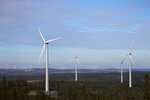News Release from RenewableUK
Wind Industry Profile of
Planning system needs overhauling to enable green hydrogen projects to go ahead
The Government has set a target of installing 10 gigawatts (GW) of low carbon hydrogen production capacity by 2030, half of which will be green hydrogen generated by renewables, including wind. To meet this target, the amount of green hydrogen we produce would have to be about a hundred times bigger than it is now.
Green hydrogen can be used in a wide range of sectors which have proved to be difficult to decarbonise so far, including generating heat for heavy industry and providing fuel for transport. It can also be stored to be used whenever it is needed, providing flexibility and ensuring the UK can always meet its energy needs.
Several small-scale green hydrogen plants are already operating in the UK, and a number of larger projects are in planning or have consent to go ahead. But the report, “Planning for Onshore Green Hydrogen”, warns that the current planning regime is too slow, complex and difficult to navigate for developers to build projects at the scale and speed which is needed. It identifies major sticking points and puts forward multiple recommendations to overcome these. The document also offers a go-to guide for developers hoping to navigate the current planning system.
Unlike other renewable technologies, there is limited national planning guidance specific to green hydrogen across the UK, so local planning authorities and national governments have a very limited framework to provide guidance. Also, it is unclear whether a green hydrogen project built alongside large wind or solar farms to make use of their clean power can be included in the same planning application as an integral part of the site, or whether they need a separate planning application under a separate regime. The report recommends updating guidance to include green hydrogen, taking due account of the target set by Government. The report also notes that there is a need to explain to decision makers how this innovative technology works, as it is not yet widely understood and the knowledge gap is hampering progress.
Green hydrogen is generated by electrolysis; splitting water into oxygen and hydrogen using an electrolyser. The report highlights the need to ensure that water used for green hydrogen production is managed sustainably. It suggests that Government and industry should work together to devise a strategic approach involving the use of water sources (e.g. waste water and sea water) in hydrogen production to minimise any impact on water supplies, which are dwindling in some parts of the UK.
The report also states that the Health and Safety Executive and environmental regulators are at present unable to process the pipeline of green hydrogen projects fast enough, as they have insufficient resources to do so. It notes that they too have limited guidance on how to deal with this innovative technology, and that they have no remit to deliver net zero. This could be addressed by ensuring that they have access to adequate funding, as well as updating guidance for the HSE and environmental agencies, including a net zero mandate.
RenewableUK’s Senior Policy Analyst for Emerging Technologies Laurie Heyworth, who wrote the report, said: “Green hydrogen is a game-changing technology which has vital role to play in the UK’s transition to net zero, as it’s a flexible clean power source which can be used across an extraordinarily wide range of sectors, and it can be stored so that we can use it whenever we need it, adding vital security and flexibility to our modern energy system. But at the moment there’s a policy vacuum in the planning system which makes limited reference to this cutting-edge technology. So we need to see planning guidance overhauled to enable new projects to go ahead as swiftly as possible to build a new industry and help us to meet our climate change goals. This report sets out in detail the changes which we need to make this happen as a matter of urgency”.
RenewableUK’s EnergyPulse database shows that 4.2MW of green hydrogen electrolyser capacity has been installed so far in the UK (15 projects). The pipeline of all green hydrogen electrolyser projects at any stage of development (operational, under construction, approved, in the planning system or at an early stage of development) stands at 1,479MW (83 projects). This includes 1,410MW (32 projects) in early stage development.
RenewableUK’s “Planning for Onshore Green Hydrogen” report is available here.
- Source:
- RenewableUK
- Author:
- Press Office
- Link:
- www.renewableuk.com/...
- Keywords:
- RenewableUK, government, UK, hydrogen, report, planning, energy security, regime, gigawatts, capacity, sector, complex, slow, energy transition



























